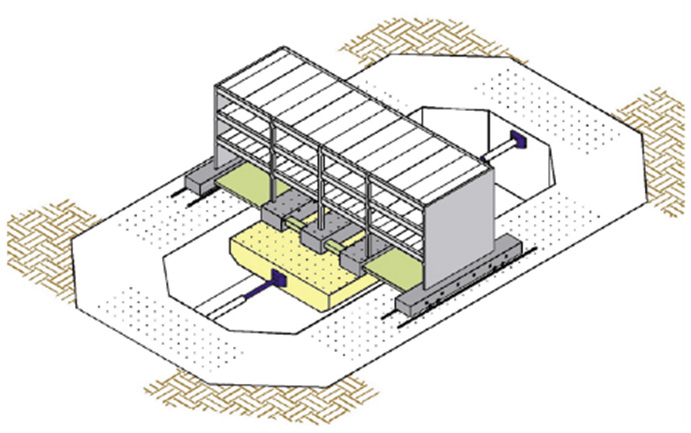This is a landmark test funded by NSF GOALI, the Precast/Prestressed Concrete Institute and the Charles Pankow Foundation. This project will assess the behavior of long-span precast concrete diaphragms to input earthquake excitation. This is a pre-NEES project being carried out by a multi-university consortium: University of Arizona, Lehigh University and the University of California at San Diego. Extensive testing on precast concrete floor connections is taking place at LU. Computational modeling is being performed at UA and UCSD.
The signature test will be a one-half scale three story totally precast concrete building at NEES-UCSD. This project is of large magnitude: the building will exceed the footprint of the LHPOST platen and will be instrumented with approximately 650 sensors, including strain gages, accelerometers, pressure, and displacement sensors. A rendering of the building and the principal objectives of the research project are presented at the following website: www.pci.org/view_file.cfm?file=JL-05-NOVEMBER-DECEMBER-4.pdf
For this building, displacements will be measured by means of a GPS system. As experienced in the testing of a full-scale seven-story shear wall structure, the use of a GPS system is essential for acquiring reliable x, y, z displacements data in an outdoor environment.
Results
The researchers subjected this building to a series of 15 simulated earthquakes, each lasting about 20 seconds. Hundreds of sensors installed throughout the building recorded a wealth of data about the seismic responses of the floor diaphragms and other elements of the structure. By comparing these responses to those predicted by their computer models, the DSDM researchers have refined the models to ensure that they accurately represent the seismic behavior of precast floor diaphragms. These models are being used to fine-tune the estimates of diaphragm design factors, which are being incorporated into a new procedure for designing diaphragms.
The DSDM Task Group is working with PCI on plans for disseminating the Methodology through PCI's Web site and technical literature, as well as working with agencies such as the American Society of Civil Engineers and American Concrete Institute to help develop national standards relating to seismic design and construction. These standards, which are expected to be updated in 2011, are incorporated by reference into the International Building Code, which regulates building design and construction in the U.S.

Investigators
| PI | Robert Fleischman | University of Arizona |
| Co-PI | Jose Restrepo | UC San Diego |
| Co-PI | Andre Filiatrualt | University at Buffalo |
| Co-PI | Clay Naito | Lehigh University |
| Co-PI | Richard Sause | Lehigh University |
| Co-PI | S.K., Ghosh | S.K. Ghosh Associates |
| Student | Matthew Schoettler | UC San Diego |
| Student | Ge Wan | Lehigh University |
| Student | Liling Cao | Lehigh University |
Contact
Robert Fleischman
rfleisch@engr.arizona.edu